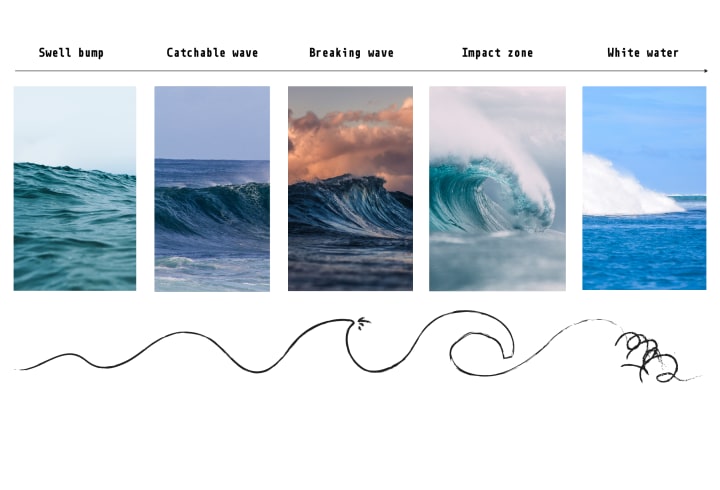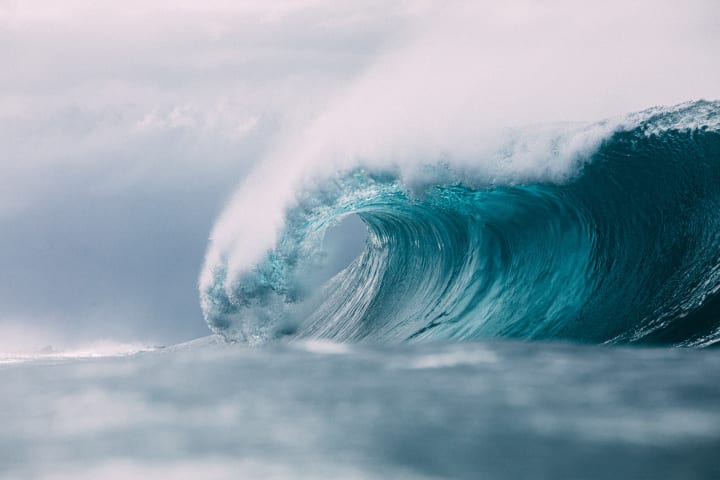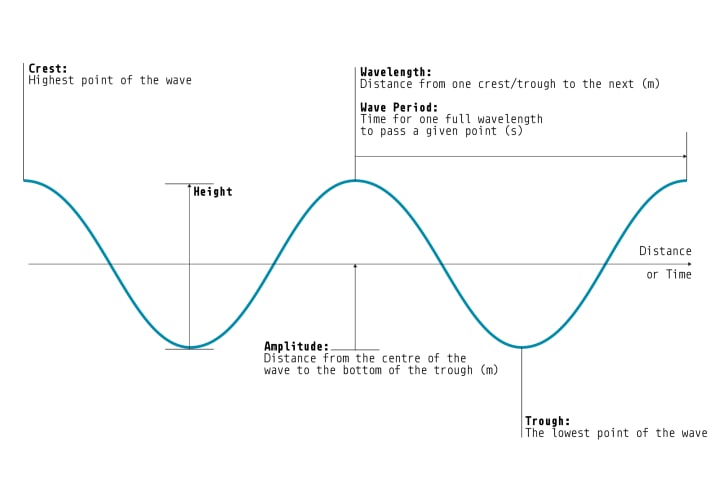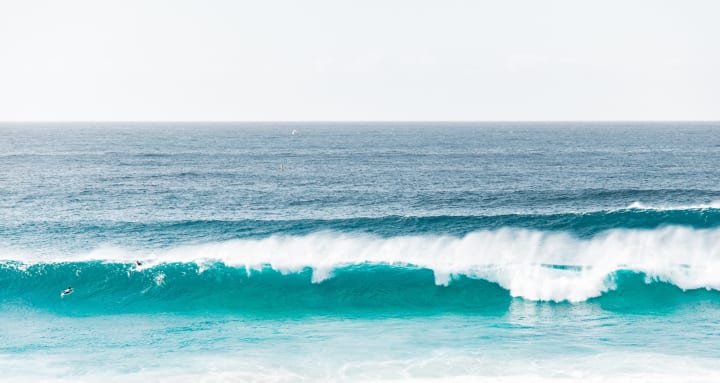
There is no such thing as an ocean with no waves. And there’s no such thing as a person without mood changes. However, the mood waves that come with bipolar disorder have higher crests and lower troughs.
In Note #2, I describe how the factors that create bipolar mood changes reflect the factors that create surfing waves. In this note, I dig deeper into how bipolar mood waves mimic the anatomy of surfing waves.
“Most people experience mood changes at some time, but those related to bipolar disorder are more intense than regular mood changes''. (Medical News Today)

For both surfing and bipolar disorder, it is beneficial to learn to recognize the moment where waves start to form swell bumps, transform into larger waves, break at their peaks, transition to lips, form tubes, and crash at their impact zones. (see illustration 2,3)
Useful surfing knowledge to know is that a big part of a wave's power is located in the lip. “The larger the wave the more intense and “heavy” the lip can be”, and so, the more dangerous it is to be caught in the impact zone of that lip.
Experienced surfers are able to ride the tube under the closing lip. Most surfers consider the peak to be “the best place to catch a wave (when surfing green waves) as [they] can slide down into the pocket to continue riding the wave down or sideways towards the face/shoulder of the wave.” (Go Surf Perth)
And beginners work their way up to the peak by first learning to surf in the white water, at least 3 meters away from the impact zone, where the wave is more settled). This zone is basically reserved for beginners to practice catching and riding wave after wave, after wave.
“[White water] is the safest, most forgiving playground . . . it offers countless hours of confidence building, learning, freedom and fun.” (Surf and Nourish)
I wish there was this kind of safe-zone playground to practice surfing immense mood waves before they happen for the first time. I only ever learned safe practices after falling hard off of waves of mania and depression, after feeling crushed, disoriented, helpless and almost drowning. Nowadays, the therapy sessions are my safe-zone playground to learn, build confidence, practice and analyze techniques for riding my mood waves.

The journey to feeling invincible often starts with an increase in energy, confidence, and positive attitude. From there, the presence of the creative trio–imagination, inventiveness, inspiration–increases, and the desire to sleep decreases. The wave gets higher, and the high becomes euphoric. Thoughts race, jumping quickly from one idea to another, making it hard to concentrate, the speech becomes pressured. And then comes the ”unrealistic, grandiose beliefs about one’s abilities or powers, impaired judgment and impulsiveness, and acting recklessly without thinking about the consequences”. The all-powerful and destined for greatness - a self-perception that is hard to resist. But it has a tendency to spiral out of control into self-destructive behavior. (Hep Guide)

When a person with bipolar disorder is in a manic state, they feel like an untouchable surfer, able to ride waves at their very peak or even at the lip, where they can fly above everything, against all physics and common sense. Looking at the anatomy of the wave, there is nothing under the lip, and the higher the wave is, the more painful it is to fall from the lip of that wave.
On the other hand, experiencing a depressive state feels like being at the trough of a wave, in the impact zone. You're at your lowest point, not accepting or believing in yourself. You feel like you're drowning, and like the coming wave is going to crush you over and over again.
The wave often starts with unexplainable physical and mental sluggishness, and decreased ability to concentrate. The mind begins to feel foggy, feelings of sadness and hopelessness come along with self-doubt, loss of energy, and there is an increased desire to sleep longer hours. Then the depressive wave grows with these symptoms, adding the feeling of guilt, extreme fatigue and feelings of worthlessness. There is loneliness and no desire or willpower to continue.

The feeling of helplessness that comes with depressive episodes and the experience of getting trapped in the impact zone leave deep marks in individuals’ memories. The weight of fear can be paralyzing, but it can also push many, including myself, to learn more about mental health and water safety. This learning, even when acquired from a need for self-preservation, can keep us safe and alive longer.
Sailors have their own ways of defining waves too, in the same way that mental health professionals have their own way of describing the elements of bipolar disorder.

In sailing, wavelength is measured in meters and wave period in seconds. The period between bipolar disorder manic and depressive episodes are measured in days, weeks or sometimes even years. The longer the time period of calm waters, the easier it is to feel like your diagnosis might have been wrong. That is until a higher wave comes along.
We can use the wave characteristics to describe the mood waves, their steepness, height, and amplitude. Using these measures, we can define the intensity of a mood episode, its influence on daily functioning and the perception of reality and personal abilities.
For mentally stable people, the amplitude of the mood waves are smaller, the wavelength and wave periods longer. But no matter how balanced your mental health is, the waves, in some form, will be there.
“Having a better understanding of how things work is going to make you more comfortable . . . you are going to be able to make predictions as you are surfing, you are going to be able to catch more waves and you will be able to stay out of trouble” (Surfer Tom Doig)

For those of us with bipolar disorder, larger waves become part of our regular life pictures. This is why understanding bipolar disorder waves and how to improve our surfing techniques is important for helping us to not feel overpowered, and instead, more in control of the waves. We can even learn to use the unique specifics of the waves to our benefit. More on that in one of the next articles.
Thank you for reading, talk soon.
Varvara 🤍
____________________________________________
CREDITS:
- Copyediting by Carmel Kundai
- Cover image: photo by Ben Warren
- Illustration 1: photo by Jeremy Bishop, annotations by Varvara
- Illustration 2: photo collage from various images from Unsplash, annotations by Varvara
- Illustration 3: edited version of Wave Characteristics by Varvara
*the author is writing from personal experience living with bipolar disorder and learning to surf. For any clinical information or if you/somebody you know is struggling with the weight of bipolar disorder, depression, or another aspect of their mental health, please reach out to a professional. Same applies to surfing--please search for professional channels to learn surfing.
About the Creator
Varvara
Hello






Comments
There are no comments for this story
Be the first to respond and start the conversation.